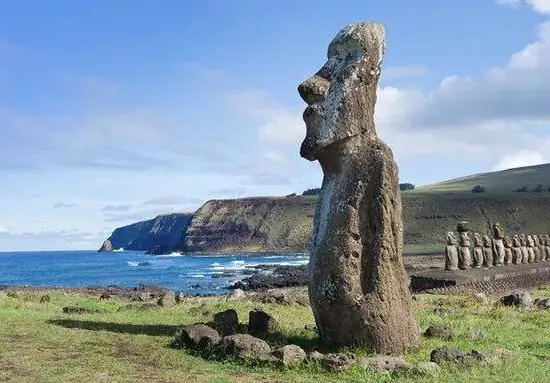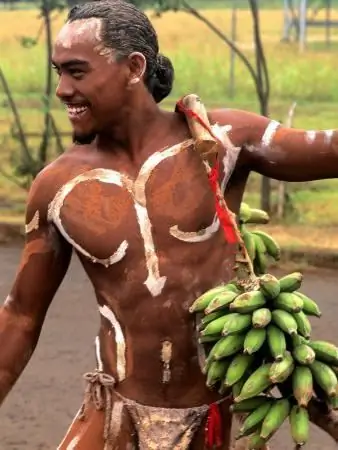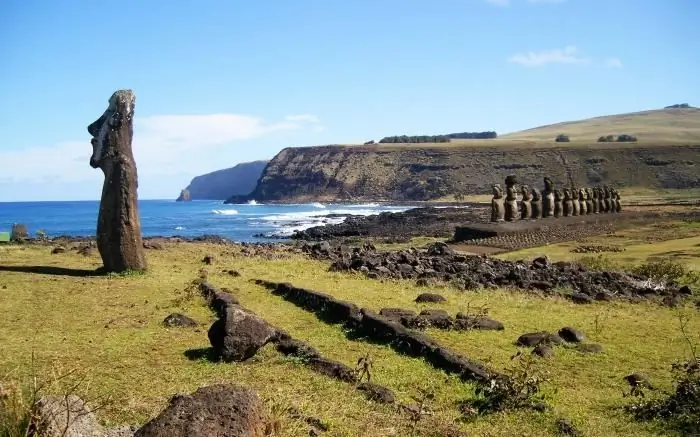- Author Harold Hamphrey [email protected].
- Public 2023-12-17 10:06.
- Last modified 2025-01-24 11:10.
Easter Island is the most remote inhabited piece of land in the world. Its area is only 165.6 square kilometers. Belongs to the island of Chile. But to the nearest mainland city of this country, Valparaiso, 3703 kilometers. And there are no other islands nearby, in the eastern part of the Pacific Ocean. The nearest inhabited land is located at 1819 kilometers. This is Pitcairn Island. It is known for the fact that the rebellious crew of the Bounty ship wished to stay on it. Lost in the Pacific Ocean, Easter Island holds many secrets. First, it is not clear where the first people came from. They could not explain anything to the Europeans about this. But the most mysterious mysteries of Easter Island are its stone idols. They are installed along the entire coastline. The natives called them moai, but they could not clearly explain who they were. In this article, we have tried to summarize the results of all recent scientific discoveries in order to unravel the mysteries that have enveloped the most remote landmass from civilization.

History of the islandEaster
On April 5, 1722, the sailors of a squadron of three ships under the command of the Dutch navigator Jacob Roggeveen saw land on the horizon that had not yet been marked on the map. When they approached the east coast of the island, they saw that it was inhabited. The natives sailed to them, and their ethnic composition struck the Dutch. Among them were Caucasians, Negroids and representatives of the Polynesian race. The Dutch were immediately struck by the primitive technical equipment of the islanders. Their boats were riveted from bits of wood and so let the water through that half of the people in the canoe bailed it out, while the rest rowed. The landscape of the island was more than bleak. Not a single tree rose on it - only rare bushes. Roggeven wrote in his diary: "The desolated appearance of the island and the exhaustion of the natives suggest the barrenness of the land and extreme poverty." But most of all, the captain was shocked by the stone idols. How, with such a primitive civilization and scarce resources, did the natives have the strength to carve out of stone and deliver so many heavy statues to the shore? The captain had no answer to that question. Since the island was discovered on the day of the Resurrection of Christ, it received the name Easter. But the natives themselves called it Rapa Nui.

Where did the first inhabitants of Easter Island come from
This is the first puzzle. Now more than five thousand people live on the island with a length of 24 kilometers. But when the first Europeans landed on the shore, there were much fewer natives. And in 1774, the navigator Cook counted only seven hundredislanders emaciated from hunger. But at the same time, among the natives there were representatives of all three human races. Many theories have been put forward about the origin of the population of Rapa Nui: Egyptian, Mesoamerican and even completely mythical, that the islanders are survivors of the collapse of Atlantis. But modern DNA analysis shows that the first Rapanui landed around the year 400 and most likely came from East Polynesia. This is evidenced by their language, which is close to the dialects of the inhabitants of the Marquesas and Hawaiian Islands.

The rise and fall of civilization
The first thing that caught the eye of the discoverers were the stone idols of Easter Island. But the earliest sculpture dates back to 1250, and the latest (unfinished, left in the quarry) - to 1500. It is unclear how the civilization of the natives developed from the fifth to the thirteenth centuries. Perhaps, at a certain stage, the islanders moved from a tribal society to clan military unions. Legends (very contradictory and fragmentary) tell of the leader Hotu Matu'a, who was the first to set foot on Rapa Nui and brought all the inhabitants with him. He had six sons who divided the island after his death. Thus, the clans began to have their ancestor, whose statue they tried to make larger, more massive and more representative than that of the neighboring tribe. But what caused the Rapa Nui people to stop carving and erecting their monuments in the early sixteenth century? This has only been discovered by modern research. And this story could beinstructive for all mankind.

Environmental disaster on a small scale
Let's leave the idols of Easter Island aside for now. They were carved by the distant ancestors of those wild natives who were caught by the expeditions of Roggeven and Cook. But what influenced the decline of the once rich civilization? After all, the ancient Rapa Nuans even had a written language. By the way, the texts of the found tablets have not yet been deciphered. Scientists have only recently given an answer to what happened to this civilization. Her death was not quick due to a volcanic eruption, as Cook assumed. She agonized for centuries. Modern studies of the soil layers have shown that the island was once covered with lush vegetation. The forests abounded with game. The ancient Rapa Nui were engaged in agriculture, growing yams, taro, sugarcane, sweet potatoes and bananas. They went out to sea in good boats made from the hollowed out trunk of a palm tree and hunted dolphins. The fact that the ancient islanders ate well is indicated by DNA analysis of food found on pottery shards. And this idyll was destroyed by the people themselves. Forests were gradually cut down. The islanders were left without their fleet, and consequently, without the meat of ocean fish and dolphins. They have already eaten all the animals and birds. The only food of the Rapa Nui people was crabs and shellfish, which they collected in shallow water.

Easter Island: Moai statues
The natives could not really say anything about how they were made and, most importantly, how stone idols weighing several tons were brought to the shore. They arethey called them "moai" and believed that they contained "mana" - the spirit of the ancestors of a certain clan. The more idols, the stronger the concentration of supernatural power. And this leads to the prosperity of the clan. So when the French removed one of the Easter Island moai statues in 1875 to take it to a Paris museum, the Rapa Nui had to be held back with guns. But, as studies have shown, about 55% of all idols were not transported to special platforms - “ahu”, but remained standing (many in the primary processing stage) in a quarry on the slope of the Rano Raraku volcano.

Art Style
In total, there are more than 900 statues on the island. They are classified by scholars chronologically and by style. The early period is characterized by stone heads without a body, with the face turned upwards, as well as pillars, where the torso is made in a very stylized way. But there are exceptions. So, a very realistic figure of a kneeling moai was found. But she remained standing in the ancient quarry. In the Middle Age, the idols of Easter Island became giants. Most likely, the clans competed with each other, trying to show that their mana is more powerful. Artistic decoration in the Middle period is more sophisticated. The bodies of the idols are covered with carvings depicting clothes and wings, and on the head of the moai are often huge cylindrical hats made of red tuff.
Transportation
No less of a mystery than the idols of Easter Island was the secret of their transfer to the "ahu" platforms. The natives claimed that moaicame there on their own. The truth turned out to be more prosaic. In the lowest (more ancient) soil layers, scientists have found the remains of an endemic tree that is related to the wine palm. It grew up to 26 meters, and its smooth trunks without branches reached a diameter of 1.8 m. The tree served as an excellent material for rolling sculptures from the quarries to the shore, where they were installed on platforms. To erect idols, ropes were used, which were woven from the bast of the hauha tree. The ecological catastrophe also explains why more than half of the sculptures are “stuck” in quarries.

Short-eared and long-eared
Modern residents of Rapa Nui no longer have religious reverence for moai, but consider them their cultural heritage. In the mid-50s of the last century, the researcher Thor Heyerdahl uncovered the secret of who created the idols of Easter Island. He noticed that Rapa Nui is inhabited by two types of tribes. In one, the earlobes were lengthened from childhood by wearing heavy jewelry. The leader of this clan, Pedro Atana, told Thor Heirdal that in their family, the ancestors passed on to their descendants the art of creating the status of moai and transporting them by drag to the installation site. This craft was kept secret from the "short-eared" and was passed down orally. At the request of Heyerdahl, Atan, with numerous assistants from his clan, carved a 12-ton statue into a quarry and delivered it upright to the platform.






